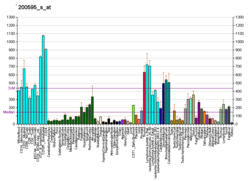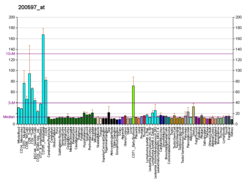EIF3A
Protein-coding gene in the species Homo sapiens
| EIF3A | |||||||||||||||||||||||||||||||||||||||||||||||||||
|---|---|---|---|---|---|---|---|---|---|---|---|---|---|---|---|---|---|---|---|---|---|---|---|---|---|---|---|---|---|---|---|---|---|---|---|---|---|---|---|---|---|---|---|---|---|---|---|---|---|---|---|
| |||||||||||||||||||||||||||||||||||||||||||||||||||
| Identifiers | |||||||||||||||||||||||||||||||||||||||||||||||||||
| Aliases | EIF3A, EIF3, EIF3S10, P167, TIF32, eIF3-p170, eIF3-theta, p180, p185, eukaryotic translation initiation factor 3 subunit A | ||||||||||||||||||||||||||||||||||||||||||||||||||
| External IDs | OMIM: 602039; MGI: 95301; HomoloGene: 2779; GeneCards: EIF3A; OMA:EIF3A - orthologs | ||||||||||||||||||||||||||||||||||||||||||||||||||
| |||||||||||||||||||||||||||||||||||||||||||||||||||
| |||||||||||||||||||||||||||||||||||||||||||||||||||
| |||||||||||||||||||||||||||||||||||||||||||||||||||
| |||||||||||||||||||||||||||||||||||||||||||||||||||
| |||||||||||||||||||||||||||||||||||||||||||||||||||
| Wikidata | |||||||||||||||||||||||||||||||||||||||||||||||||||
| |||||||||||||||||||||||||||||||||||||||||||||||||||
Eukaryotic translation initiation factor 3 subunit A (eIF3a) is a protein that in humans is encoded by the EIF3A gene.[5][6][7] It is one of the subunits of Eukaryotic initiation factor 3 (eIF3) a multiprotein complex playing major roles in translation initiation in eukaryotes.
Interactions
EIF3A has been shown to interact with:
See also
References
- ^ a b c GRCh38: Ensembl release 89: ENSG00000107581 – Ensembl, May 2017
- ^ a b c GRCm38: Ensembl release 89: ENSMUSG00000024991 – Ensembl, May 2017
- ^ "Human PubMed Reference:". National Center for Biotechnology Information, U.S. National Library of Medicine.
- ^ "Mouse PubMed Reference:". National Center for Biotechnology Information, U.S. National Library of Medicine.
- ^ Johnson KR, Merrick WC, Zoll WL, Zhu Y (April 1997). "Identification of cDNA clones for the large subunit of eukaryotic translation initiation factor 3. Comparison of homologues from human, Nicotiana tabacum, Caenorhabditis elegans, and Saccharomyces cerevisiae". J. Biol. Chem. 272 (11): 7106–13. doi:10.1074/jbc.272.11.7106. PMID 9054404.
- ^ Nagase T, Seki N, Tanaka A, Ishikawa K, Nomura N (1995). "Prediction of the coding sequences of unidentified human genes. IV. The coding sequences of 40 new genes (KIAA0121-KIAA0160) deduced by analysis of cDNA clones from human cell line KG-1". DNA Res. 2 (4): 167–74, 199–210. doi:10.1093/dnares/2.4.167. PMID 8590280.
- ^ "Entrez Gene: EIF3S10 eukaryotic translation initiation factor 3, subunit 10 theta, 150/170kDa".
- ^ Morris JA, Kandpal G, Ma L, Austin CP (July 2003). "DISC1 (Disrupted-In-Schizophrenia 1) is a centrosome-associated protein that interacts with MAP1A, MIPT3, ATF4/5 and NUDEL: regulation and loss of interaction with mutation". Hum. Mol. Genet. 12 (13): 1591–608. doi:10.1093/hmg/ddg162. PMID 12812986.
- ^ a b c d e f g h i j Mayeur GL, Fraser CS, Peiretti F, Block KL, Hershey JW (October 2003). "Characterization of eIF3k: a newly discovered subunit of mammalian translation initiation factor elF3". Eur. J. Biochem. 270 (20): 4133–9. doi:10.1046/j.1432-1033.2003.03807.x. PMID 14519125.
- ^ a b c d e f g Block KL, Vornlocher HP, Hershey JW (November 1998). "Characterization of cDNAs encoding the p44 and p35 subunits of human translation initiation factor eIF3". J. Biol. Chem. 273 (48): 31901–8. doi:10.1074/jbc.273.48.31901. PMID 9822659.
- ^ Harris TE, Chi A, Shabanowitz J, Hunt DF, Rhoads RE, Lawrence JC (April 2006). "mTOR-dependent stimulation of the association of eIF4G and eIF3 by insulin". EMBO J. 25 (8): 1659–68. doi:10.1038/sj.emboj.7601047. PMC 1440840. PMID 16541103.
- ^ Méthot N, Rom E, Olsen H, Sonenberg N (January 1997). "The human homologue of the yeast Prt1 protein is an integral part of the eukaryotic initiation factor 3 complex and interacts with p170". J. Biol. Chem. 272 (2): 1110–6. doi:10.1074/jbc.272.2.1110. PMID 8995410.
- ^ a b c d e f g Ewing RM, Chu P, Elisma F, Li H, Taylor P, Climie S, McBroom-Cerajewski L, Robinson MD, O'Connor L, Li M, Taylor R, Dharsee M, Ho Y, Heilbut A, Moore L, Zhang S, Ornatsky O, Bukhman YV, Ethier M, Sheng Y, Vasilescu J, Abu-Farha M, Lambert JP, Duewel HS, Stewart II, Kuehl B, Hogue K, Colwill K, Gladwish K, Muskat B, Kinach R, Adams SL, Moran MF, Morin GB, Topaloglou T, Figeys D (2007). "Large-scale mapping of human protein-protein interactions by mass spectrometry". Mol. Syst. Biol. 3: 89. doi:10.1038/msb4100134. PMC 1847948. PMID 17353931.
- ^ a b Morris-Desbois C, Réty S, Ferro M, Garin J, Jalinot P (December 2001). "The human protein HSPC021 interacts with Int-6 and is associated with eukaryotic translation initiation factor 3". J. Biol. Chem. 276 (49): 45988–95. doi:10.1074/jbc.M104966200. PMID 11590142.
- ^ Asano K, Kinzy TG, Merrick WC, Hershey JW (January 1997). "Conservation and diversity of eukaryotic translation initiation factor eIF3". J. Biol. Chem. 272 (2): 1101–9. doi:10.1074/jbc.272.2.1101. PMID 8995409.
- ^ Méthot N, Song MS, Sonenberg N (October 1996). "A region rich in aspartic acid, arginine, tyrosine, and glycine (DRYG) mediates eukaryotic initiation factor 4B (eIF4B) self-association and interaction with eIF3". Mol. Cell. Biol. 16 (10): 5328–34. doi:10.1128/MCB.16.10.5328. PMC 231531. PMID 8816444.
- ^ Gradi A, Imataka H, Svitkin YV, Rom E, Raught B, Morino S, Sonenberg N (January 1998). "A novel functional human eukaryotic translation initiation factor 4G". Mol. Cell. Biol. 18 (1): 334–42. doi:10.1128/mcb.18.1.334. PMC 121501. PMID 9418880.
- ^ Henis-Korenblit S, Strumpf NL, Goldstaub D, Kimchi A (January 2000). "A novel form of DAP5 protein accumulates in apoptotic cells as a result of caspase cleavage and internal ribosome entry site-mediated translation". Mol. Cell. Biol. 20 (2): 496–506. doi:10.1128/mcb.20.2.496-506.2000. PMC 85113. PMID 10611228.
- ^ Lagirand-Cantaloube J, Offner N, Csibi A, Leibovitch MP, Batonnet-Pichon S, Tintignac LA, Segura CT, Leibovitch SA (April 2008). "The initiation factor eIF3-f is a major target for atrogin1/MAFbx function in skeletal muscle atrophy". EMBO J. 27 (8): 1266–76. doi:10.1038/emboj.2008.52. PMC 2367397. PMID 18354498.
Further reading
- Dong Z, Zhang JT (2006). "Initiation factor eIF3 and regulation of mRNA translation, cell growth, and cancer". Crit. Rev. Oncol. Hematol. 59 (3): 169–80. doi:10.1016/j.critrevonc.2006.03.005. PMID 16829125.
- Kanner SB, Reynolds AB, Vines RR, Parsons JT (1990). "Monoclonal antibodies to individual tyrosine-phosphorylated protein substrates of oncogene-encoded tyrosine kinases". Proc. Natl. Acad. Sci. U.S.A. 87 (9): 3328–32. Bibcode:1990PNAS...87.3328K. doi:10.1073/pnas.87.9.3328. PMC 53893. PMID 2110361.
- Scholler JK, Kanner SB (1997). "The human p167 gene encodes a unique structural protein that contains centrosomin A homology and associates with a multicomponent complex". DNA Cell Biol. 16 (4): 515–31. doi:10.1089/dna.1997.16.515. PMID 9150439.
- Zhang Y, LeRoy G, Seelig HP, Lane WS, Reinberg D (1998). "The dermatomyositis-specific autoantigen Mi2 is a component of a complex containing histone deacetylase and nucleosome remodeling activities". Cell. 95 (2): 279–89. doi:10.1016/S0092-8674(00)81758-4. PMID 9790534. S2CID 18786866.
- Tong JK, Hassig CA, Schnitzler GR, Kingston RE, Schreiber SL (1998). "Chromatin deacetylation by an ATP-dependent nucleosome remodelling complex". Nature. 395 (6705): 917–21. Bibcode:1998Natur.395..917T. doi:10.1038/27699. PMID 9804427. S2CID 4355885.
- Block KL, Vornlocher HP, Hershey JW (1998). "Characterization of cDNAs encoding the p44 and p35 subunits of human translation initiation factor eIF3". J. Biol. Chem. 273 (48): 31901–8. doi:10.1074/jbc.273.48.31901. PMID 9822659.
- Ensinger C, Obrist P, Mikuz G, Merkx G, Smeets D, Bänziger R, Bachmann F, Burger M (1998). "Assignment1 of the p150 subunit of the eukaryotic initiation factor 3A gene (EIF3A) to human chromosome band 10q26 by in situ hybridisation". Cytogenet. Cell Genet. 83 (1–2): 74–5. doi:10.1159/000015130. PMID 9925932. S2CID 2664052.
- Zhang Y, Ng HH, Erdjument-Bromage H, Tempst P, Bird A, Reinberg D (1999). "Analysis of the NuRD subunits reveals a histone deacetylase core complex and a connection with DNA methylation". Genes Dev. 13 (15): 1924–35. doi:10.1101/gad.13.15.1924. PMC 316920. PMID 10444591.
- Humphrey GW, Wang Y, Russanova VR, Hirai T, Qin J, Nakatani Y, Howard BH (2001). "Stable histone deacetylase complexes distinguished by the presence of SANT domain proteins CoREST/kiaa0071 and Mta-L1". J. Biol. Chem. 276 (9): 6817–24. doi:10.1074/jbc.M007372200. PMID 11102443.
- Lin L, Holbro T, Alonso G, Gerosa D, Burger MM (2001). "Molecular interaction between human tumor marker protein p150, the largest subunit of eIF3, and intermediate filament protein K7". J. Cell. Biochem. 80 (4): 483–90. doi:10.1002/1097-4644(20010315)80:4<483::AID-JCB1002>3.0.CO;2-B. PMID 11169732. S2CID 35848129.
- Pincheira R, Chen Q, Zhang JT (2001). "Identification of a 170-kDa protein over-expressed in lung cancers". Br. J. Cancer. 84 (11): 1520–7. doi:10.1054/bjoc.2001.1828. PMC 2363652. PMID 11384103.
- Saito M, Ishikawa F (2002). "The mCpG-binding domain of human MBD3 does not bind to mCpG but interacts with NuRD/Mi2 components HDAC1 and MTA2". J. Biol. Chem. 277 (38): 35434–9. doi:10.1074/jbc.M203455200. PMID 12124384.
- v
- t
- e
| Initiation factor |
| ||||||||||||||||||||
|---|---|---|---|---|---|---|---|---|---|---|---|---|---|---|---|---|---|---|---|---|---|
| Elongation factor |
| ||||||||||||||||||||
| Release factor | |||||||||||||||||||||
| Ribosomal Proteins |
|
 | This article on a gene on human chromosome 10 is a stub. You can help Wikipedia by expanding it. |
- v
- t
- e



















